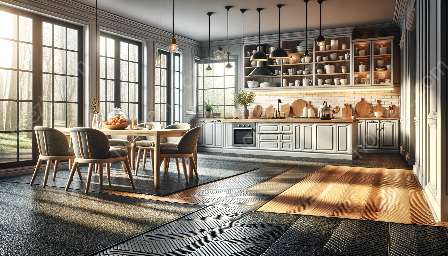If you're remodeling your kitchen or building a new one, you've probably spent hours choosing the perfect flooring material to match your aesthetics and practical needs. But have you considered the acoustic properties of your kitchen flooring? Sound absorption and noise reduction are essential factors to consider, especially in a space where cooking, dining, and socializing happen regularly.
Importance of Acoustic Properties in Kitchen Flooring
The kitchen is a bustling and often noisy environment, with activities ranging from cooking and conversation to the clattering of dishes and utensils. The right flooring material can significantly impact the acoustics of the space, creating a more enjoyable and functional environment.
Sound Absorption and Noise Reduction
When it comes to kitchen flooring, sound absorption and noise reduction are crucial considerations. Sound absorption refers to the ability of a material to dampen or absorb sound waves, preventing them from bouncing off hard surfaces and creating echo or reverberation. Noise reduction, on the other hand, relates to the material's ability to minimize the transmission of impact or airborne noise from one space to another.
Best Flooring Options for Sound Absorption
Several flooring materials excel in sound absorption, making them ideal choices for kitchen environments. Cork flooring, for example, is a popular option known for its natural sound-absorbing properties. Its cellular structure helps dampen sound, reducing the impact of footsteps and minimizing noise from dropped items. Similarly, rubber flooring offers excellent sound absorption, making it a suitable choice for kitchens where noise reduction is a priority.
Noise-Reducing Flooring Materials
While sound absorption is important, noise reduction is equally critical, especially in multi-story homes or apartments where kitchen noise can disturb occupants in adjacent rooms. Engineered wood flooring with underlayment provides good noise reduction by damping impact and airborne noise. Additionally, luxury vinyl flooring with an attached acoustic underlayment is designed to minimize noise transmission, creating a quieter kitchen environment.
Practical Considerations for Kitchen Flooring
When evaluating the acoustic properties of kitchen flooring, it's essential to consider other practical factors such as ease of maintenance, water resistance, and durability. Cork, for instance, is not only a sound-absorbing material but also provides cushioning underfoot and is resistant to moisture—a crucial consideration in kitchens. When exploring noise-reducing flooring options, be sure to prioritize materials that offer easy maintenance and long-lasting performance to suit the demands of a kitchen environment.
Enhancing Your Kitchen and Dining Experience
By understanding the acoustic properties of kitchen flooring and selecting the right material, you can enhance your overall kitchen and dining experience. Whether you prioritize a quiet cooking space, reduced noise transmission, or a combination of both, the right flooring choice can contribute to a more pleasant and functional kitchen environment.
Conclusion
When choosing kitchen flooring, it's important to consider not only the visual appeal and durability of the material but also its acoustic properties. By prioritizing sound absorption and noise reduction, you can create a more comfortable and enjoyable kitchen and dining space. With the right flooring selection, you can minimize noise, enhance acoustics, and elevate the overall experience in one of the most used areas of your home.







































